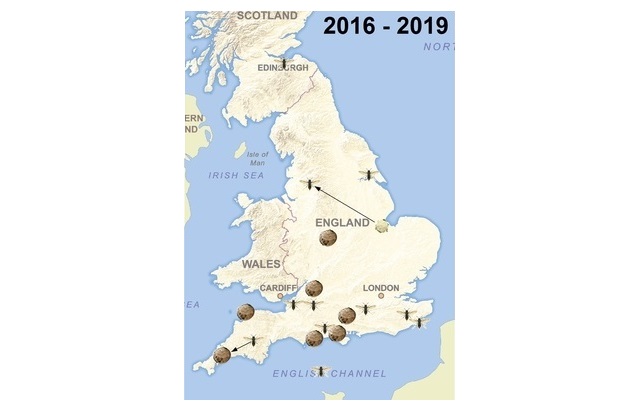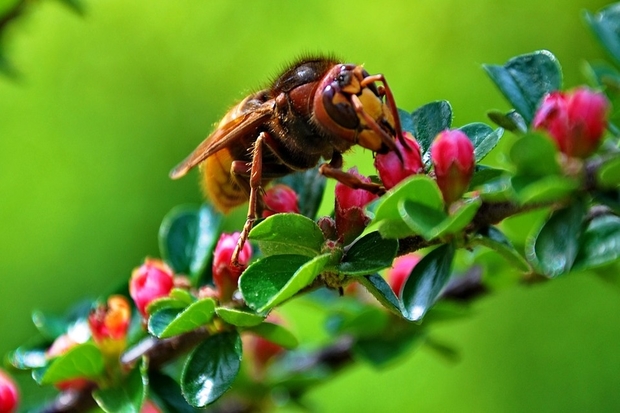Breaking News
As this goes to print, Pete Davies and the team are dealing with a confirmed Asian hornet sighting in the Gosport area in Hampshire. If you live in this area, please remain vigilant and be sure to report any suspected sightings straight away. Please see the full news story here.
To mark Asian Hornet Week, we hear from Peter Davies, Regional Bee Inspector for Southern England as he talks about the threat of the Asian hornet, the work APHA do in controlling this non-native invasive predator and what you should do if you spot one.
My name is Peter Davies and I am Regional Bee Inspector for Southern England covering Wiltshire, Dorset, Hampshire & Isle of Wight, Berkshire, Oxfordshire, Buckinghamshire and Northamptonshire.
Along with my NBU colleagues I have been involved in the eradication of Asian hornet incursions into the UK mainland for many years.

Background
The Asian hornet is an ‘invasive non-native species’ which inadvertently got imported into Southern France in 2004. From there it colonised all of France and parts of Spain, Portugal, Italy, Germany, Netherlands, Belgium and the Channel Islands.
In each of the last 4 years, there have been incursions onto the UK mainland with individuals being found in Somerset, Kent, Surrey, East Yorkshire, Lancashire and Scotland. Nests also have been found and, in line with UK and European Government policy, been destroyed in Gloucestershire, Devon, Cornwall, Hampshire and Staffordshire.

Scientific study by Fera suggests that these incursions are a result of mated queens coming into the UK mainland with imported goods or vehicles. Once the weather warms up they start making a primary nest. Some individual drones (males) have also been found close to the south coast having, we believe, flown across the channel assisted by favorable tail winds. These, on their own, provide a much lesser threat than reproductive queens.
The threat they pose
Asian hornets are a non-native invasive predator of medium to large insects. They pose a serious threat to our native pollinators and, throughout the summer, honey bees can make up a substantial part of their diet as they build their nests up to several thousand individuals.

Once a honey bee colony is located as a food source, the hornets visit it in increasing numbers relentlessly preying on the bees. It is much like a takeaway to them and they can decimate the numbers of bees until the colony collapses. They also prey on native pollinators like hover flies or wasps and, just to mix it up, are very partial to prawns from the fish market stands as observed in France!
Asian hornet carry a venomous sting which can cause severe reaction and, sadly, some deaths have been recorded in Asia and Europe. Although not naturally aggressive, they can be defensive around their nest and the more they become established the more incidents are reported. Much like our wasps, they like over-ripe fruit at the end of summer and there have been reports of stings whilst picking ripe grapes and plums.
Asian hornet identification
The Asian hornet (Vespa velutina) has some distinct identifying features, it is mostly black with a single yellow/orange band towards the top of its abdomen, it has yellow socks, an orange face and is slightly smaller than our native European hornet, but larger than a wasp. Click here for an identification sheet.
Action stations!
‘It’s how big?’ the lady on the phone continued to describe the huge buzzy insect bashing itself against the inside of her conservatory windows where it had taken up residence the previous evening.
The size and noise of it had caught her attention and she had remembered seeing an alert poster for Asian hornet at her local garden centre. An internet search convinced her enough to download the Asian Hornet Watch app (available on iPhone and Android) and report it with a photo.
The report was forwarded to the National Bee Unit (NBU) by the UK Centre of Ecology & Hydrology (CEH) who triage UK sightings. Because of its proximity to a previous confirmed incursion and the clear description, although the photo was too distant and blurred to positively identify, this report was followed up a very credible sighting.
After gathering a few more details from the lady on the phone, I passed this information on to my local inspector for the area. The location was less than a couple of miles from a nest site from the previous year so was of particular interest. The inspector arranged to visit and identify the insect trapped in the conservatory. On this occasion he was joined by a local beekeeper who is a member of the local beekeepers’ AHT (Asian Hornet Team) who act as a local liaison with our NBU and help triage reported sightings and monitor traps and feed stations. You can find your local AHT here.
As an AHT, they are trained by their local Beekeeping Association in identifying Asian hornets and have an understanding of the lifecycle and foraging habits. As Beekeepers, they have a vested interest in keeping the Asian hornet at bay and have a good general knowledge of most ‘buzzing’ flying insects. Their help and co-operation is invaluable to us in responding to some of the 6000 - 8000 reports annually.
Once at the location the inspector and AHT fortunately identified the insect as a native European hornet (Vespa crabro), it was ushered to a corner and released through an open window. The lady was thanked for her report and given an identification sheet for future reference.

Dealing with an incursion
When a report comes in with a photograph that can be clearly identified as an Asian hornet, the NBU local contingency operation swings into action.
Firstly, the local inspector will head to the location to try and collect a sample hornet to send to FERA science at Sand Hutton for a formal identification and possible genetic analysis.
Secondly, a small team of 4- 6 inspectors and an incident commander assemble at the location to start the ground work to enable monitoring and tracking operations to commence. This will involve door to door visits with information sheets to gain the public’s help and support as we may need access to gardens, private property and grounds as well as public spaces. The team need to familiarise themselves with the local area, terrain and locations of amenities services such as hospitals and access routes.
A Forward Operating Base (FOB) location is identified by APHA’s Resilience & Technical Advisors. This may be within a local fire station, Environment agency, Forestry Commission buildings, or village hall. The FOB allows the incident response to be managed safely and appropriately in a controlled environment and is a base to liaise with local authorities, land owners, general public, local beekeepers and AHT’s. It also allows a local base for staff briefings, risk assessments, handovers and equipment to be issued from a regional stores.
To bolster NBU experience in Asian hornets track and trace techniques last summer, six inspectors spent a week training in Jersey where Asian hornets are present. This training was invaluable as mainland training is limited to real incursions of which thankfully there have not been many!

As part of the track and trace process NBU Inspectors are deployed in teams of two to monitor and track the hornets to their nest. They establish a series of mobile feed stations which can be moved forward down the line of sight toward the nest. Several feed stations allow triangulation of the nest location. The nests may be sited in tree tops at over 30m or in bushes or shrubs and anywhere in between.

Whilst working in close proximity to a nest site the area is cordoned off and Hornet sting-proof suits and gloves are worn to protect us from defensive behavior. Once the nest is located, APHA’s National Wildlife Management Centre attend to carry out the ‘destruction’. The next day the nest is removed and sent to FERA Science for analysis.
How you can help

Asian hornets become much more active in late summer, much like our native wasps, as nests get to their maximum size. All UK Asian hornet nests to date have been found in September and October.
Asian Hornet week is from 7th-13th September and we are encouraging everyone to:
- download the free Asian Hornet Watch iPhone orAndroid app
- familiarise yourself with what the hornets look like
- keep a look out on late summer flowering plants such as Ivy where the hornets (and other insects) forage on the flowers.
- report suspect sightings using the ‘Asian Hornet Watch’ app or, by filling out an online report formor by emailing alertnonnative@ceh.ac.uk.
We, in the UK, are at the Northern edge of the Asian hornet’s European range and, by working together, hope to keep this invasive species at bay and protect our nation’s important pollinators.

2 comments
Comment by Robert trickey posted on
I have got three dead hornets but not sure if Asian in Llanhennock near CAERLEON Newport South Wales. I have still got them.
Comment by Heather O'Sullivan posted on
Hi Robert, please ensure you report this using the ‘Asian Hornet Watch’ app or, by filling out an online report form or by emailing alertnonnative@ceh.ac.uk as described in this blog.
Thank you for your comment.